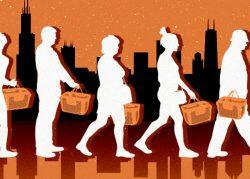DSW is walking away from State Street, an important shopping corridor, dealing a blow to the nascent recovery of the Chicago Loop’s retail market.
The shoe retailer is exiting about 26,000 square feet at the Sullivan Center at 35 State Street after 10 years, Crain’s reported. The closure is a loss for White Plains, New York-based Acadia Realty Trust, which bought the 200,000 square feet of retail space at the base of the building for $147 million in 2016.
DSW’s departure further depletes a market where vacancies reached a record 27.4 percent this year, according to brokerage Stone Real Estate. Disney, New York & Company and Urban Outfitters closed retail outlets on State Street during the pandemic.
Retailers have been hit especially hard by the rise of remote work and its persistence as the preferred arrangement for many employees even as the virus has waned. The heart of Chicago’s central business district is dominated by offices, meaning there were few tenants of residential buildings to backfill support for retailers and eateries when the work lunch crowds disappeared.
Yet the Sullivan Center has qualities that may make it more attractive than other storefronts — its retail space had been 95 percent leased at the end of March with DSW still in place. The Central Loop submarket, which includes State Street, proved more resilient than the overall Loop, as its retail vacancy fell to 23.4 percent this year from 26.1 percent in 2021, Stone found.
While that’s still much higher than the 14.7 percent vacancy rate in 2019, it signals that a recovery is beginning on State, the birthplace of the large American department store.
JD Sports, owner of the Finish Line shoe chain, is opening a store at 10 South State formerly occupied by Forever 21, and the discount retailer Five Below is taking over a store at 36 South State that was left by Blick Art Materials for a new store on Randolph Street just off State. The Block 37 mall has also added some new tenants, such as Danish menswear brand Lindbergh.
So far, though, the suburbs have led the way for Chicago retail. More retail buildings sold for $1 million or more in the metro area in the year ended in March than any year for more than two decades, according to brokerage Marcus & Millichap.
“Urban cores, as the cities continue to get reactivated with people back in the office, you’ll continue to see a rebound,” said Ben Wineman, a broker with Mid-America Real Estate.
Even so, sales for losses and landlords handing keys back to lenders on prominent Chicago retail properties, such as Brookfield at the Mag Mile’s Water Tower Place, are expected to pop up as merchandisers reassess strategies for the inner city.
[Crain’s] — Sam Lounsberry
Read more



